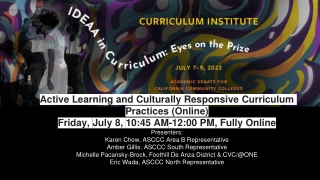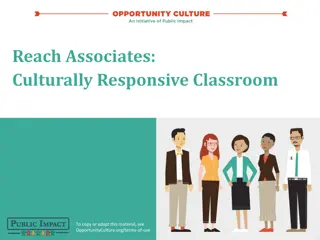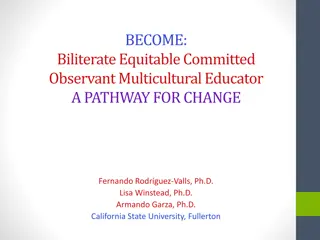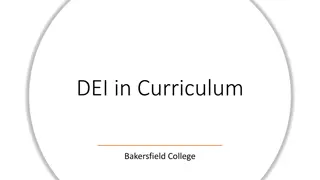Cultural Competence Workshop at St. Martin's University
Explore the importance of cultural competence in education at the Center for Strengthening the Teaching Profession workshop held at St. Martin's University. Participants will learn about personal cultural identity, regional diversity, and practical tools for culturally responsive teaching practices.
Download Presentation

Please find below an Image/Link to download the presentation.
The content on the website is provided AS IS for your information and personal use only. It may not be sold, licensed, or shared on other websites without obtaining consent from the author. Download presentation by click this link. If you encounter any issues during the download, it is possible that the publisher has removed the file from their server.
E N D
Presentation Transcript
CENTER FOR STRENGTHENING THE TEACHING PROFESSION 253-752-2082 www.cstp-wa.org Cultural Competence: Relationship over management St. Martin s University July 27, 2010 9:00 12:00 Culturally Responsive These materials funded by the Grousemont Foundation.
Who is she? make a guess How old do you think she is? Where do you think she is from? What language(s) do you think she speaks? What do you think her greatest accomplishment has been? What do you think her professional aspirations are?
Getting Started Who s here? What are we doing today?
Objectives Participants will develop a better understanding of their own personal cultural identity and how this impacts the way they develop classroom expectations. Participants will develop a basic understanding of the variety of cultures in the region and how the cultural practices impact students responses to an education system. Participants will leave with a toolkit of usable activities and materials.
Schedule for the day 1st hour 2nd hour Introductions Objectives Define terms Focus on Self What is my culture and worldview? How does this impact my decisions? 3rd hour Focus on others Who are the students I will be teaching? What are my attitudes about diversity? What do I need to know about my students and their cultures to be an effective teacher? How can I communicate and interact more effectively?
Modeling Clear expectations regular activity/movement Reflection Interaction/relationship Options Hooks Greetings/gathering folks Getting into groups
Session 1: Knowing yourself Objective: You will be able to define culture and cultural competence. You will learn about your personal culture and the culture of the community in which you live.
Activity 1: The Circle Get into a circle. For each statement you hear that is true, take a step forward and raise your hand. Debrief: How could you use this in your classroom? Write and reflect.
Define culture Culture refers to the cumulative deposit of knowledge, experience, beliefs, values, attitudes, meanings, hierarchies, religion, notions of time, roles, spatial relations, concepts of the universe, and material objects and possessions acquired by a group of people in the course of generations through individual and group striving.
Cultural Competence is Knowing the community where the school is located Understanding all people have a unique world view Using curriculum that is respectful of and relevant to the cultures represented in its student body Being alert to the ways that culture affects who we are Placing the locus of responsibility on the professional and the institution Examining systems, structures, policies and practices for their impact on all students and families
Cultural competence is not Good intentions Cultural celebrations at designated times of the year, in designated ways Kumbaya diversity A list of stereotypes about what people from a particular cultural group do Assumptions that all students from one culture operate in similar ways and have had similar experiences The responsibility of children, their parents or the community Color-blindness (treating everybody the same) Simple tolerance
What does this mean for me as a teacher? Developing cultural competence results in an ability to understand, communicate with, and effectively interact with people (students and families) across cultures.
Who am I in all of this? Until you understand your own culture, you cannot understand another s. Take out a scratch sheet of paper and respond to each of the questions you are about to see in the next slides. You will be sharing 4 of your answers (your choice) with a group of people.
Personal Inventory A What is your favorite song? How do people in your family share important information and stories? How do outsiders learn the rules of your family (e.g. In our family we don t share anything personal with outsiders; in our family we always wash our own dishes when we visit the grandparents, etc.)? Describe the common belief/faith system (or lack thereof) that is practiced by members of your family.
Personal Inventory B Describe your family s favorite way to spend free- time/vacation time. If your house was burning down, what 3 items would you try to save? Why? What activities made you happiest as a child? What experience(s) made you sad or angry? Think about your childhood. Describe the most common ways adults in your life communicated in public? Describe how members of your family deal with conflict.
Activity 3: Breaking into teams Get yourself into order by birth date without talking or making any noise. Presenter will break you into teams of 3 4.
Small group share-out Select 4 responses from the Personal Inventory to share with the other participants at your table (each person determine which four responses they are willing to share). Each member share name and ONE response quickly with whole group. Move around the table until everyone has shared 4.
Debrief Think-pair-share How could you use this in a content area or for professional development? Write and reflect.
Activity 4: Walk it out As you hear the statements, give yourself a point for each that is true for you. Total your points at the end of the activity and wait for further instructions Debrief reflect, discuss, write Share 40 Developmental Assets
Session 2: Knowing those around you Objective: You will understand how your culture colors your perceptions of others. You will be able to identify the dominant culture of the students in your classroom. You will learn the importance of valuing diversity You will learn to identify critical elements of culture You will be exposed to skills that will assist you in teaching students from diverse cultural backgrounds
Using Media There is much that can be learned by watching the experiences and responses of others.
How early does race matter? Do children still see in black and white? A Girl Like Me Kiri Davis, 2005 http://www.mediathatmattersfest.org/watch/6/
Race and Data CEDARS Requires racial self-identification If no self-identification by student or parent/family, teachers/school staff are REQUIRED to visually identify the student s race COULD YOU IDENTIFY EACH OF YOUR STUDENT S RACE?
What is the impact of race? What s Race Got To Do With It http://www.pbs.org/race/005_MeMyRaceAndI/005_00-home.htm
Does race impact achievement or is it just poverty? What is the problem?
Washington State 10 Year Student Picture Group 1998-99 2009-10 Net Change All # 999,616 1,040,750 + 41,134 White 759,708 (76%) 672,350 (64.8%) -87,358 (-11.2%) Am Indian/Alaska 27,989 (2.8%) 27,363 (2.6%) -626 (-0.2%) Latino 90,965 (9.1%) 158,612 (15.3%) +67,647 (+6.2%) African American 50,980 (5.1%) 56,790 (5.5%) +5,810 (+0.4%) Asian Am/Pacific Is 70,973 (7.1%) 89,231 (8.6%) +18,258 (1.5%) Bilingual/ELL 5.1% 8% +2.9%
If nothing changes 4th Grade African American 2022 (12yrs) Latino Native American 2029 (19yrs) Reading 2022 (12yrs) Math 2042 (32yrs) African American 2017 (7yrs) 2050 (40yrs) Latino 2049 (39yrs) Native American 2018 (8yrs) 10th Grade Reading 2017 (7yrs) Math 2064 (54yrs) 2056 (46yrs) 2058 (48yrs)
High school graduation rates 2007-08 American Indian Other Pacific Islander Black Latino All Students White Asian/Pacific Islander Asian 0% 10% 20% 30% 40% 50% 60% 70% 80% 90% 100% On-time Graduation Rate Extended Graduation Rate
What is the impact of race and/or culture on your students? Let s talk about YOUR kids!
Personal Brainstorm: When you think about developing classroom expectations, what are the 3 most important expectations? What happens if these expectations are in conflict with your students expectations or with your building s expectations?
Group brainstorm As a table group, have a conversation about the following: When your expectations and the school s expectations are different, what do you think happens to kids? How can you impact change in this area?
Taking it a step further Respond based on your experiences as a student: Who were the students who were most successful in your school? Who were the students who experience the greatest challenges? How was culture celebrated/ignored at your school? Describe the behaviors of students who were in conflict with the practices/expectations of your school building.
What have you learned about these communities? What are the ways students/youth interact with adults/elders? What are the most effective methods of communicating with parents? Who are the community leaders? What important traditions/holidays need to be recognized/acknowledged? Anything else?
How can you learn more? Find an adult/parent with whom you can have coffee 1 2 times per month. Visit ethnic restaurants in your community and take notes about: How families interact. How adults and children share space. Noise levels. What you hear when you close your eyes. Foods you try that you have never eaten before. Visit religious sites/institutions where your students worship. Commit to attending cultural events in the community
Debrief/ wrap-up Questions and Answers
Questions and Answers
Free Trainings Communicating with parents from diverse backgrounds CISL and OEO Developing authentic school- family community partnerships CISL Understanding Washington State s achievement gap CISL Developing a strategic plan to address the achievement gap - CISL Understanding Civil Rights OSPI and WEA Cultural Competence for educators CISL and WEA Creating culturally competent systems - OSPI Cultural competence build relationships with your families and community!!!
Websites with FREE resources www.yourlearningcenter.org (Center for the Improvement of Student Learning) best practices research, translated materials, achievement gap studies, free training videos, interviews, power points, upcoming statewide events, Q & A, etc. www.governor.wa.gov/oeo/ (Office of the Education Ombudsman) information for parents, upcoming trainings; www.cstp-wa.org (Center for the Strengthening of the Teaching Profession) Research on teaching practice, state ELL study, teacher advocacy trainings; www.edtrust.org (Education Trust) national best practice models and data on addressing the achievement gap, real stories!, upcoming conferences; www.teachingtolerance.org teaching strategies to address cultural awareness student-to-student and teacher-to-student, lesson plans, activity grants, free supplies www.montgomeryschools.md.org sample district strategic plan to address the achievement gap (this district has done more than any other in the nation to address the achievement gap) MUST CHECK OUT!!!
CISL resources Website: www.yourlearningcenter.org Achievement Gap Oversight and Accountability Committee recommendations and agendas Free training/support materials Achievement gap Cultural competence Authentic family/community/school partnerships Contact information: cisl@k12.wa.us (360) 725 - 6503
Contact us: Erin Jones erin.jones@k12.wa.us Maria Flores maria.flores@k12.wa.us Center for the Improvement of Student Learning Assistant: Jessica Cole (360) 725 - 6503 cisl@k12.wa.us























